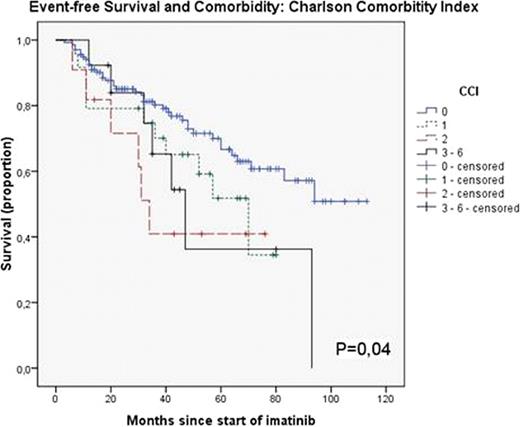Abstract
Abstract 2296
Comorbidity in cancer has been shown to be a major determinant in treatment selection and survival. The most used instrument for measuring comorbidity in Hematology is the Charlson comorbidities index (CCI). It is a list of 19 conditions with weight assigned from 1 to 6, derived from relative risk estimates of a proportional hazard regression model using clinical data. The ACE-27 is a 27 item comorbidity index for patients with cancer and assign weights from 1 to 3 based on the dysfunction grade of each condition. Little is known about the impact of comorbidity in chronic myeloid leukemia (CML).
Our objectives were to evaluate the impact of comorbidity in the outcomes of a cohort of chronic phase chronic myeloid leukemia (CP-CML) patients (pts) treated with imatinib and compare the results from the 2 indexes (CCI and ACE-27).
We conducted a retrospective study in a cohort of patients with CP-CML from a south Brazilian database. All patients received imatinib 400mg as first or second-line therapy. Patient evaluation and response criteria followed the European LeukemiaNet recommendations. Comorbidity conditions were registered at any point during evaluation and CCI and ACE-27 scores were applied to each patient. The outcomes were event-free survival rate (EFS) and imatinib temporary suspension rate. EFS was measured from the start of imatinib to the date of any of the following events while on therapy: death from any cause, loss of complete hematologic response, loss of complete cytogenetic response, discontinuation of therapy for toxicity or lack of efficacy, or progression to accelerated phase or blastic phase. Imatinib suspensions were considered if superior to 20 days. We conducted 3 types of analysis concerning treatment suspension: suspension for any reason (toxicity and nonadherence), suspension only due to toxicity and only due to nonadherence to treatment.
We analyzed data from 185 pts with CP-CML diagnosed since 1990. The median age at diagnosis was 48 years (range 4 – 85). The median time from diagnosis to imatinib was 7 months (range 0 – 178) and 29% of pts had more than 12 months lapse. Prior therapy with interferon was used in 70% pts. CCI distribution among pts: score point 0 was assigned to 136 pts, score point 1 to 24 pts, score point 2 to 11 pts, score point 3 – 6 to 13 pts and 1 pt with missing information. ACE-27 distribution among pts: score point 0 was assigned to 92 pts, score point 1 to 51 pts, score point 2 to 21 pts, score point 3 to 19 pts and 2 pts with missing information. The indexes showed a strong correlation (Spearman's coefficient 0,7, P<0,0001). The projected EFS rate at 4 years was 68% after a median follow-up time of 4 years. We found a significant association between both indexes and EFS rate at 4 years. The EFS in each group of ICC was: 73% in score 0 group, 65% in score 1 group, 41% in score 2 group and 36% in score 3 to 6 group (P=0,04, Fig 1). The EFS in each group of ACE-27 was: 80% in score 0 group, 69% in score 1 group, 56% in score 2 group and 33% in score 3 group (P<0,001, Fig 2). A significant association between both indexes and drug temporary suspension rate was also found. For the CCI, 32% of score 0 pts had at least one suspension due to any reason, compared to 41% of pts with score 1, 46% of pts with score 2 and 73% of pts with score 3–6 (P=0,04). Subgroup analysis revealed a significant association between CCI and interruption due to toxicity (P=0,03) and due to nonadherence (P=0,03). For the ACE-27, 32% of score 0 pts had at least one suspension due to any reason, compared to 36% of pts with score 1, 27% of pts with score 2 and 69% of pts with score 3 (P=0,03). Subgroup analysis revealed a significant association between ACE-27 and interruption due to toxicity (P=0,02) but not due to nonadherence (P=0,69).
In our population of pts with CP-CML, event-free survival, imatinib toxicity and nonadherence seem to be associated with the presence of comorbidities. Both CCI and ACE-27 can be used in the stratification of patients at risk to have major toxicities, lack of adherence or an event during treatment with imatinib. ACE-27 was a better tool in predicting EFS, in the other way, CCI was superior in predicting nonadherence.
No relevant conflicts of interest to declare.
Author notes
Asterisk with author names denotes non-ASH members.



This feature is available to Subscribers Only
Sign In or Create an Account Close Modal